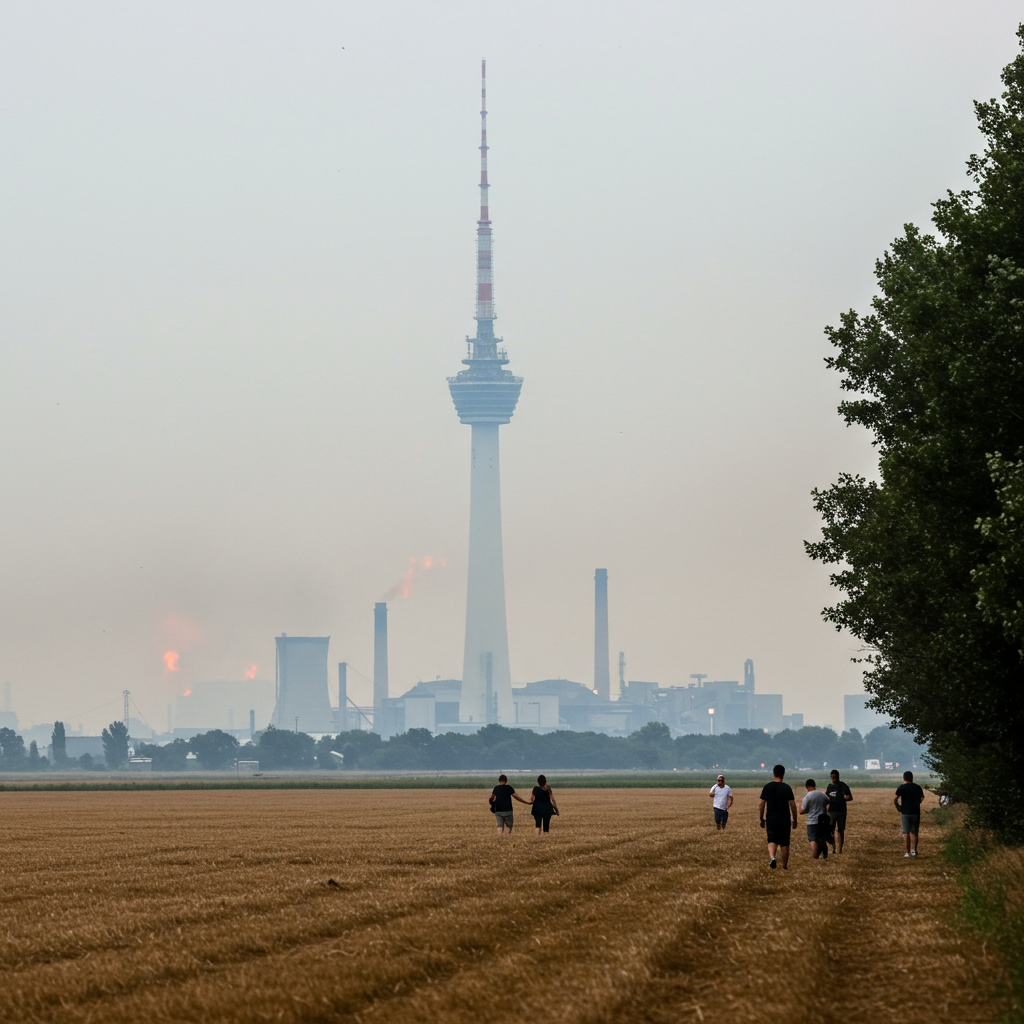Europe faced a summer of unprecedented intensity as a severe heatwave gripped the continent in early July 2025. Record-breaking temperatures triggered widespread alerts, forced iconic landmarks to close, and strained critical infrastructure, highlighting the escalating impact of extreme weather events. From sweltering city centers to parched rural landscapes battling wildfires, the crisis underscored Europe’s vulnerability to rising global temperatures. This period saw tragic deaths, urgent evacuations, and significant disruption to daily life and essential services across multiple nations.
Extreme Heat Grips Nations: From Red Alerts to Fatalities
The heatwave’s severity prompted immediate, urgent responses from authorities across Europe. Several countries issued heat alerts, escalating to rare “red” levels in multiple regions, the highest classification signifying a potential danger to life. This triggered emergency measures, including school closures, public transport adjustments, and restrictions on public gatherings. The human cost became tragically clear early in the week, with reports of heat-related deaths in multiple locations, stark reminders of the direct threat posed by these extreme conditions.
France Implements Crisis Measures
France was particularly hard hit, with the national weather service placing sixteen départements, including the entire greater Paris Île-de-France region, under a rare red alert. Temperatures soared, exceeding 40°C (104°F) in many southern areas and hitting up to 41°C (106°F) in some red alert zones. The intensity persisted through the night, with Paris experiencing temperatures as high as 30°C (86°F) well after midnight.
The heat created multiple crises simultaneously. Over 1,300 schools were partially or fully closed, as poorly ventilated classrooms became dangerously hot. City authorities in Paris activated a pollution plan, restricting traffic to limit smog exacerbated by the heat and implementing lower speed limits. Firefighters across the country responded to over 300 weather-related emergencies, dealing with everything from heat-related medical calls to burgeoning wildfires. Adding to infrastructure challenges, the Golfech nuclear reactor in the southwest was temporarily shut down because the River Garonne’s water temperature was too high for safe cooling operations. Even the iconic Eiffel Tower was affected, closing its summit to visitors. High temperatures caused the tower’s wrought iron structure to expand and tilt slightly, a known phenomenon that doesn’t compromise its integrity but necessitates safety closures during extreme heat.
Switzerland’s Power Production Halted by Hot Rivers
Further demonstrating the heat’s impact on infrastructure, Switzerland’s energy sector faced disruptions. Energy company Axpo significantly reduced output at its Beznau nuclear power plant. The plant relies on cooling water from the River Aare. Swiss environmental regulations strictly prohibit returning cooling water to the river if its temperature reaches or exceeds 25°C (77°F). This rule protects sensitive aquatic ecosystems from thermal pollution. Due to critically high river temperatures, Axpo had already been scaling back operations for days before being forced to completely shut down one of the plant’s reactor units. The remaining unit was operating at only 50% capacity.
Wildfires Rage and Infrastructure Strains
Across Southern Europe, the intense heat fueled devastating wildfires. Spain experienced tragic consequences when a wildfire in the Catalonia region claimed two lives. Prime Minister Pedro Sánchez conveyed his condolences and emphasized the extreme risk of forest fires, urging the public to take every precaution. Catalonia’s civil protection services battled ongoing blazes in three distinct areas while warning of a high risk spreading to additional regions. This fire crisis followed Spain’s hottest June on record, with temperatures having already topped 40°C (104°F) in cities like El Granado.
Italy also grappled with the severe conditions. The Health Ministry issued red alerts for a staggering sixteen cities, including major metropolitan centers like Rome and Milan. Authorities in thirteen regions, including Lombardy and Emilia, strongly advised residents to avoid any form of outdoor work during the hottest parts of the day. Italy reported two heat-related fatalities, including a 47-year-old construction worker near Bologna, underscoring the particular danger faced by those whose jobs require outdoor labor. Meanwhile, in Turkey, wildfires burned fiercely for a second consecutive day, forcing the evacuation of over 50,000 people by emergency management teams. Even the United Kingdom, typically less prone to extreme heat, felt the effects; the previous month marked its second warmest June since record-keeping began in 1884. Visitors across the continent sought any available shade, from the ancient landmarks of Rome to bustling city parks.
The Science Behind the Swelter: Understanding the Heat Dome
The immediate cause of this widespread and intense heatwave was attributed to a meteorological phenomenon known as a “heat dome.” A heat dome forms when a persistent area of high atmospheric pressure settles over a region. This high pressure acts like a lid, trapping warm air beneath it and preventing it from rising and dissipating. It effectively seals off cooler weather systems, allowing heat to build day after day. In this instance, the heat dome stalled over western Europe, drawing in and trapping hot air masses originating from North Africa. These systems can linger for days or even weeks, leading to prolonged periods of extreme heat and stifling humidity across the affected area.
Linking Local Crisis to Global climate Trends
While the immediate cause was a heat dome, this severe event fits into a larger, concerning pattern amplified by climate change. Scientific studies consistently show that rising global temperatures are increasing the frequency, intensity, and duration of heat waves around the world. As the planet continues to warm due to human-caused greenhouse gas emissions, extreme weather events like this are expected to become more commonplace and more severe, a trend highlighted by organizations like the World Meteorological Organization.
Compounding the issue, Europe has been identified by the European Union’s Copernicus Climate Change Service as the world’s fastest-warming continent, heating up at twice the global average speed. This rapid warming makes the region particularly susceptible to more frequent and extreme heat events. The human rights implications of such severe heatwaves were underlined by the UN’s human rights chief, Volker Turk. He stated that rising temperatures, alongside other climate impacts like sea-level rise, floods, droughts, and wildfires, pose a direct threat to fundamental human rights, including the rights to life, health, and a clean, healthy, and sustainable environment. Turk stressed that the heatwave serves as a stark reminder of the urgent need for climate adaptation and, crucially, a transition away from fossil fuels, which the UN’s Intergovernmental Panel on Climate Change (IPCC) identifies as the primary driver of climate change.
Frequently Asked Questions
What caused the extreme heatwave experienced across Europe?
The immediate cause was a meteorological phenomenon called a “heat dome.” This is a high-pressure system that remained stalled over western Europe, effectively trapping warm air beneath it. This trapped air, originating in part from North Africa, prevented cooler weather from entering the region, leading to temperatures building up significantly over several days and creating the intense heatwave.
What were some specific impacts of the heatwave across different European countries?
The heatwave led to diverse impacts. In France, rare red alerts were issued, the Eiffel Tower’s top level closed, a nuclear reactor shut down due to high river temperature, and schools closed. Spain experienced deadly wildfires. Switzerland also saw a nuclear reactor unit shut down because river water used for cooling exceeded regulatory temperature limits designed to protect aquatic life. Italy issued numerous city-wide red alerts and advised against outdoor work during peak heat, sadly reporting heat-related deaths. Turkey battled wildfires requiring mass evacuations.
How is this severe heatwave linked to climate change?
While immediate weather patterns like heat domes cause individual events, scientific consensus, supported by organizations like the WMO and IPCC, indicates that climate change increases the frequency, intensity, and duration of heat waves globally. Europe is warming faster than the global average, making it particularly vulnerable to such extreme events. The UN human rights chief highlighted that these increasingly severe weather patterns are linked to the need to move away from fossil fuels, the main driver of climate change.
The severe European heatwave of July 2025 served as a potent and alarming demonstration of how rising global temperatures translate into tangible, immediate crises affecting infrastructure, public health, the environment, and even basic human rights. The closure of iconic landmarks, critical power infrastructure failures, deadly wildfires, and tragic loss of life underscore the urgent need for both robust climate adaptation strategies and accelerated efforts to mitigate climate change by transitioning away from fossil fuels. As Europe, the fastest-warming continent, faces increasingly frequent and intense heat events, the lessons learned from this sweltering summer are critical for preparing for a warmer future.




